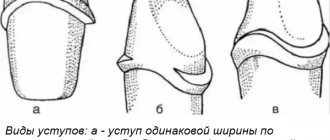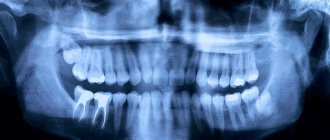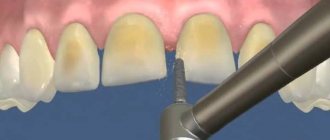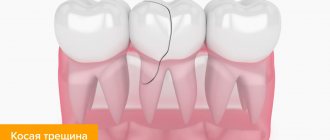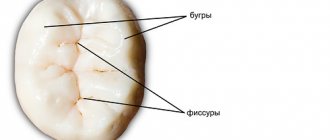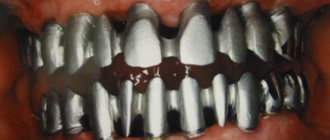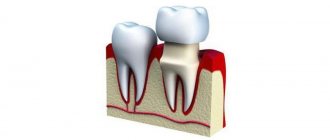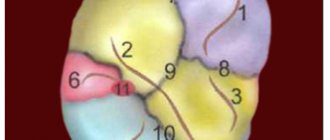Preparation is a preparatory stage of tooth processing, during which the doctor evenly grinds down the layers of dentin and tooth enamel from the surface. Proper turning ensures the tightest possible fit of dentures to the stump: inlays, dental crowns, bridges.
Depending on the material of the orthopedic structures, the teeth may be subjected to heavy or minimal grinding. For example, a larger layer of tooth enamel is ground off under metal-ceramics than when using prosthetics with zirconium or ceramic crowns. In this article we will talk about methods of tooth preparation and what features each type of grinding has.
Rules for grinding teeth
- The doctor must prepare the patient: explain that you cannot move sharply during preparation, and if necessary, you need to give a sign with your left hand.
- Grinding of living teeth under a metal-ceramic crown is carried out only under anesthesia.
- The preparation is carried out as sparingly as possible: the doctor should not grind off hard tissue more than is required to restore the tooth with a crown while maintaining its anatomical shape.
- It is impossible to grind teeth continuously: during processing there should be frequent breaks, during which the tooth is irrigated with water to avoid overheating of hard tissues.
- Before work, the dentist must check the technical serviceability of the drill and the fixation of the burs in the grinding tip.
Classifications of plastic crown designs
Plastic crowns differ in base materials:
- Plastic, based on acrylic mass.
- Metal-plastic, with a metal base and a plastic outer covering.
In operation, they have different service lives. Crowns with an acrylic base will last about 2 years, and with metal admixtures - more than 5 years.
Metal-plastic products are highly durable. However, they require special requirements for the strength and accuracy of fixing the plastic coating to the metal base.
Types of tooth preparation for crowns
- Tunnel grinding . Refers to the classic method of grinding for a metal-ceramic crown, in which the teeth are ground using a drill and a metal or diamond tip. High speeds of the turbine device can lead to overheating, so a stream of water is supplied simultaneously with the treatment. The advantages of this type of preparation include control over the layers being removed, which makes it possible to predict the result. But a drill can also often injure the mucous membrane, form microcracks and chips on the tooth.
- Ultrasonic preparation . This grinding of teeth for crowns is painless and atraumatic. After ultrasonic preparation, the ground teeth remain without chips, damage to the enamel, or injuries to the nerve bundle - during treatment the device does not come into contact with the teeth. The method is applicable only for cases when it is necessary to grind off a small amount of dental tissue.
- Laser processing . A modern method of grinding teeth for caries or for a crown. The laser instantly heats the water in the surface tissues of the enamel, which leads to microscopic destruction in the tooth. Tooth fragments are removed using a water-air mixture. This type of grinding is more expensive than others, but the price is justified by the maximum speed of the procedure, low-traumatic nature, and painlessness.
- Removing hard tissue with an air-abrasive mixture . The principles of tooth preparation with an abrasive jet are to quickly and accurately process hard tissues without heating them. A mixture of water and abrasive particles is supplied under high pressure, ensuring painless grinding. The method is especially suitable for clinical cases of grinding teeth with living pulp.
- The use of chemically active substances for grinding under dental crowns . Reagents are applied to the surface of the tooth to soften the enamel. With this grinding, there is no need for anesthetics - this is a gentle processing method that does not cause chips and cracks, but it takes up to 30 minutes to wait for the chemical composition to take effect.
Methodology for manufacturing plastic crowns
At the initial stage, the doctor takes an impression of the entire dentition. Based on the impression, specialists create a plaster model. It is this that becomes the final guideline for further production of the product. After this, using professional aligners and treatment with a quick-drying compound, plastic crowns are made directly. The final result is a dental crown that meets the required parameters and accurately follows the contours of the tooth. Having given the opportunity to harden, it can be used as a prosthetic for the patient. If the crown causes discomfort or unpleasant sensations, it must be sent for adjustment.
Features of tooth preparation for crown installation
Grinding of teeth for crowns can be done in different ways, depending on the method of prosthetics, the material of orthopedic structures, and the condition of the hard tissues of the tooth. Let's look at some common features of turning.
Grinding of teeth for metal-ceramics
The most common grinding method for metal-ceramic orthopedic structures is a ledge 900 with a bevel of 450. In other clinical cases, the doctor can process a tooth for metal-ceramics at 1350, with a jelly-shaped ledge, a symbol of the ledge.
Preparing a tooth for a cast crown
For a crown made of an all-metal or combined alloy, it is necessary to grind down a fairly large volume of hard tissue due to the massiveness of the structure. To preserve more tissue, your doctor may suggest not making a ledge for the crown. The downside of such “humane” preparation is trauma to the gingival margin, poor fit and fragility of the denture.
Preparing a tooth for a porcelain crown
For prosthetic restoration with porcelain crowns, teeth are ground in the same way as for installing cast crowns. Only the thickness of the removed layer varies - up to a maximum of 1.5 mm. This is due to the fact that ceramic crowns are not so massive and allow you to leave the maximum possible amount of hard tissue and the anatomical features of the tooth being treated.
Preparing teeth for bridges
When turning, the doctor takes into account the material from which the crowns will be made. The bridge, at the request of the patient, can be made of metal ceramics, ceramics, or zirconium dioxide. Metal ceramics are more massive than other materials, so you need to be prepared for the fact that the tooth will be depulped before turning.
Preparing a tooth for a stamped crown
The dentist removes a thin layer of hard tissue - 0.2-0.3 mm. The stamped crown has thin walls, so you can carry out the most gentle turning possible.
Preparing teeth for an artificial zirconium crown
When preparing, it is enough to remove a small layer from the surface of the teeth and make a pronounced shoulder ledge. The thickness of the crown is minimal, especially with single dentures in the smile area, and there is no need for deep treatment of the tooth.
Black tooth preparation
This is the name of tooth treatment for carious lesions of hard tissues. Turning is carried out in stages:
- Access to the cavity is created.
- Necrotic tissue is removed.
- The cavity is processed to give it a specific shape.
- The edges of the tooth enamel are processed.
- Filling a clean, treated cavity.
When using metal-ceramic prosthetics or structures made of any other materials, it is necessary to carefully grind away the layers of necrotic tissue from the teeth and fill large cavities. If you ignore this stage or do it poorly, very soon pathogenic bacteria will provoke repeated caries under the metal-ceramic crown. A severe toothache will appear, the tooth will begin to decay, which can lead to its loss.
Preparation with a ledge: a necessity or a priority
The task of preparing a tooth with or without a ledge faces, first of all, orthopedic dentists, although today in dentistry the direction of “general dentistry”, or the so-called mixed technique, is actively developing. With this approach, the boundaries between orthopedic dentists, therapists and surgeons are “blurred”. And it is no longer so important what specialty the doctor providing dental care is; what is important is the doctor’s choice in favor of one or another preparation technique.
Let's first figure out what is the meaning of creating a ledge on the stump of a prepared tooth . First of all, we note that the ledge is not a supporting element for the crown, although it takes on some of the load. The need to form a ledge is dictated, first of all, by the aesthetic and functional requirements of modern orthopedic dentistry. The thing is that any artificial crown has some minimum thickness; it consists of the thickness of the frame and the thickness of the facing material. For example, the minimum thickness of a base metal frame should be 0.3-0.4 mm. Let's add here the minimum possible layer of cladding to obtain the most modest aesthetics of 0.7 mm. As a result, we get about 1 mm of crown thickness in the edge area. According to modern requirements of dentistry, we must restore the anatomical shape of the tooth without creating overhanging edges, with a smooth transition of the crown into the contours of the tooth. And this, in turn, is not possible without the formation of a ledge .
Automatically, the question of the possibility of a non-invasive preparation technique can be “removed” from the agenda. You can talk about the “ledge symbol” only in the case of making a crown with a complete circular metal garland, which can be polished almost “to-no”, but it is quite difficult to do this efficiently, and you are guaranteed a clear loss in the aesthetics of the cervical area. So is there a need for barbaric preparation without a ledge, for creating a “ledge symbol” that is barely visible to a technician, if you can simply form a high-quality ledge using modern cutting burs?
The technology for creating a full-fledged ledge today is as simple as a multiplication table. And in this publication we will try to present it in the form of a certain sequence of actions by a doctor with appropriate explanations.
So, step number 1 . Creation of occlusal separation. (Fig. 1). We recommend performing this step with a diamond bur No. 909-xxx.
Rice. 1. Disconnection for the thickness of an artificial crown using a diamond bur No. 909-xxx
Step #2 . Removal of large volumes of tissue from the side walls of the tooth. (Fig. 2). We recommend performing this step with an aggressive grinding bur; a TDA series bur is ideal. This stage is usually accompanied by the formation of a preliminary ledge above the gum level.
Rice. 2. Removal of large volumes of tissue from the side walls of the tooth with a TDA bur. At the same time we form a preliminary ledge.
Step #3 . Formation of a completed ledge at or below the level of the gums (Fig. 3). This stage must be carried out with a carbide tool, preferably a Great White Ultra 856 bur. The design feature of this bur is the end end of the working head. In Great White Ultra burs it is increased in size and has a large radius of curvature with the constant absence of horizontal notches on the curvature of the bur head. (Fig. 4.) This design of the bur makes it simply an ideal tool for forming the final ledge on the tooth stump and finishing polishing the ledge to a glossy surface.
Fig. 3 Forming a completed ledge at or below the gum level with Great White Ultra 856 bur
Rice. 4. Simultaneous formation of the final ledge on the tooth stump and final polishing it to a glossy surface with a Great White Ultra 856 bur.
According to the literature, of the many forms of ledges, the most applicable today are ledges of 135 degrees and 90 degrees (most often, its modernized analogue with a semicircular transition between the “wall and bottom” is used). The SS WHITE company suggests that you use carbide burs of similar end-end configurations for quick and high-quality preparation.
Turning for metal-ceramics: is it painful to prepare a tooth?
In modern dentistry there are atraumatic methods and anesthetics that make grinding for crowns painless. Most often, anesthetic drugs are used to grind living teeth to relieve pain during preparation.
If the patient is allergic to painkillers, the dentist selects the most suitable treatment method: laser, chemical method, ultrasound.
Sometimes patients complain that the tooth hurts after grinding for a crown. As a rule, symptoms are short-lived and disappear a couple of days after the procedure.
The main reasons why teeth may hurt after grinding:
- Grinding away a large layer of hard tissue under metal-ceramics without first removing the nerve fiber from the pulp. The tooth becomes sensitive to temperature conditions or pressure. The pain goes away on its own after a few days.
- Trauma due to retraction cord. This is a special thread that the doctor uses to form a ledge between the teeth and the prosthesis - this is how the crown “sits” tightly on the teeth and is securely fixed with cement. The injured gum may turn red and even swell slightly, but the symptoms quickly subside.
- Inflammatory process. Pain in the teeth due to developing pulpitis and periodontitis does not go away after a couple of days, but only intensifies. In such cases, you should immediately consult a doctor for treatment. If the pain began after the crown was installed, it will require subsequent replacement.
Indications for the use of plastic crowns
Plastic crowns are recommended to be installed in the following cases:
- Combating minor defects in the front teeth (discoloration, chips, cracks or problems with bite).
- Restoring the chewing function of a specific tooth for a certain time.
- Protection of the ground tooth until the selected main prosthesis is installed.
- Restoring oratorical diction;
- Preventing tooth displacement and overgrowth of the gum bed.
Modern dentistry “Sanident” in the city of Shchelkovo provides effective and high-quality prosthetics, accessible to everyone. Our clinic’s specialists will give all the necessary recommendations and select the optimal type of prosthetics individually for each patient. Excellent service and friendly staff await you.
Clinic "Sanident" is located at the address: Shchelkovo, st. Central, no. 80.
Stages of teeth grinding
- Examination of the oral cavity, assessment of hygiene and condition of teeth and gums. If the tooth is affected by deep caries, depulpation is performed - removal of nerves from the pulp chamber.
- Making a template from silicone. It is used to properly prepare a tooth for installation of a metal-ceramic or cast crown.
- Installation of a special thread into the gum beard on the teeth to form a ledge for metal-ceramic structures.
- Calibration grooves are created, which serve as a kind of level during turning.
- After smoothing the notches, the correctness of the processing is checked with a silicone wrench, and areas requiring additional grinding are marked.
- The stump for metal ceramics is finally finished.
The preparation of each tooth is carried out differently - there is no universal method. The doctor uses those methods and types of turning that are most optimally suited to the actual clinical picture. For metal ceramics, the dentist almost always recommends removing the nerve so that the patient does not feel pain due to increased sensitivity of the teeth or so as not to provoke the development of pulpitis.
Plastic dental crowns
The material used to manufacture these crowns is profile plastic, which does not have a negative effect on the human body. The basis for plastic is an acrylic base, the chemical composition of which differs from the standard ones used for prosthetics.
Medical plastic of this type has a porous structure, which indicates the need and importance of regular and complete oral hygiene. If this is not done, the crowns will become an ideal environment for the proliferation of bacteria and microbes and will lose their aesthetic appearance.
Signs of high-quality preparation for metal-ceramics
The result of correct preparation for a stamped or cast crown must meet the following criteria:
To get detailed advice on treatment, preparation and prosthetics of teeth, sign up for a consultation at Aristocrat-Dent dentistry.
You can make an appointment by calling 8 (495) 638-05-05. Consultation is free if treatment is started on the day of treatment.
Varieties of porcelain designs
Dental porcelain is an excellent material that provides ample opportunities for aesthetic restoration. Several types of structures are made from it:
· Veneers. These are thin plates designed to hide minor defects in tooth enamel. They cover only the front surface of the tooth. Porcelain, composite or zirconium dioxide can be used in their manufacturing process.
· Tabs. These are microprostheses made in a dental laboratory. They help solve more serious dental problems with teeth and are used, for example, in cases of severe decay of the crown or the presence of a large carious cavity.
· Crowns. The most versatile design that allows you to achieve a “Hollywood” smile. They are installed on the front teeth during aesthetic restoration.
Indications and contraindications for the installation of porcelain crowns
| Indications: | Contraindications: |
|
|
Porcelain or metal-ceramic crowns?
Much more often we have to compare porcelain and metal-ceramic crowns. Structures with a metal frame have a number of advantages: they are stronger and significantly cheaper. At the same time, they lose greatly in aesthetics: all competent specialists will recommend putting porcelain crowns on your front teeth if you want your smile to be as natural as possible. It is believed that it is justified to install metal-ceramic crowns on chewing teeth, and porcelain crowns on incisors. However, if a porcelain crown has a zirconium dioxide frame, then it can be used to restore any tooth.
